Page 5 of 326
iii
Section
3
Comfort Controls and Audio Systems
Section
4
Your Driving and the Road
Section
5
Table of Contents (cont'd)
Braking/Anti-lock Brakes
Traction Control System
Steering
Driving Tips for Various Road ConditionsRecreational Vehicle Towing
Loading Your Vehicle
Towing a Trailer Heating and Air Conditioning
Setting the Radio ClockRadio/Cassette Player/CD Player
Radio Theft-Deterrent Feature
Hazard Warning Flashers
Jump Starting
Towing Your VehicleEngine Overheating
Changing a Flat Tire
If You're Stuck
Problems on the Road
Page 73 of 326
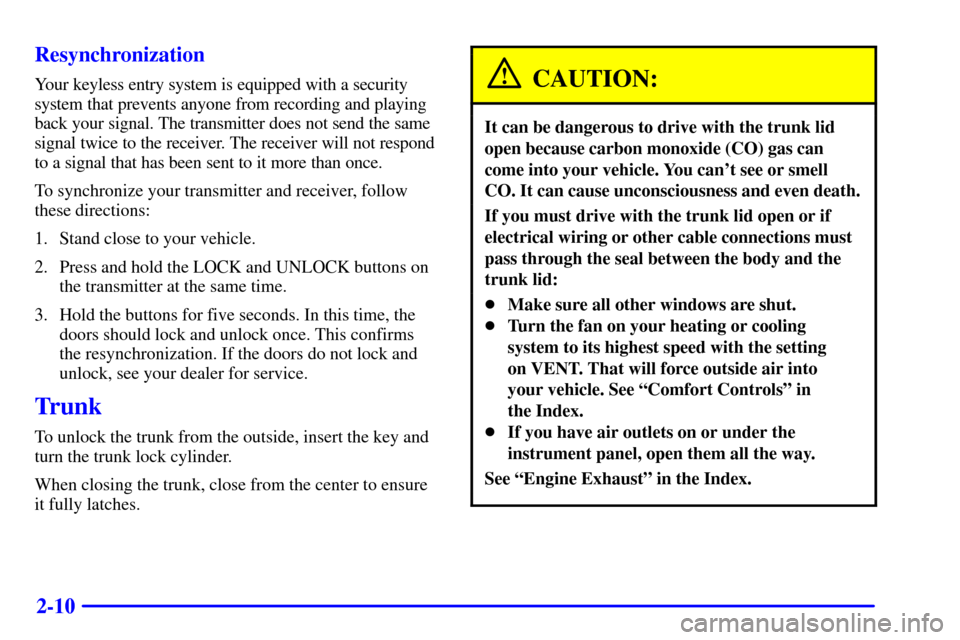
2-10 Resynchronization
Your keyless entry system is equipped with a security
system that prevents anyone from recording and playing
back your signal. The transmitter does not send the same
signal twice to the receiver. The receiver will not respond
to a signal that has been sent to it more than once.
To synchronize your transmitter and receiver, follow
these directions:
1. Stand close to your vehicle.
2. Press and hold the LOCK and UNLOCK buttons on
the transmitter at the same time.
3. Hold the buttons for five seconds. In this time, the
doors should lock and unlock once. This confirms
the resynchronization. If the doors do not lock and
unlock, see your dealer for service.
Trunk
To unlock the trunk from the outside, insert the key and
turn the trunk lock cylinder.
When closing the trunk, close from the center to ensure
it fully latches.
CAUTION:
It can be dangerous to drive with the trunk lid
open because carbon monoxide (CO) gas can
come into your vehicle. You can't see or smell
CO. It can cause unconsciousness and even death.
If you must drive with the trunk lid open or if
electrical wiring or other cable connections must
pass through the seal between the body and the
trunk lid:
�Make sure all other windows are shut.
�Turn the fan on your heating or cooling
system to its highest speed with the setting
on VENT. That will force outside air into
your vehicle. See ªComfort Controlsº in
the Index.
�If you have air outlets on or under the
instrument panel, open them all the way.
See ªEngine Exhaustº in the Index.
Page 104 of 326
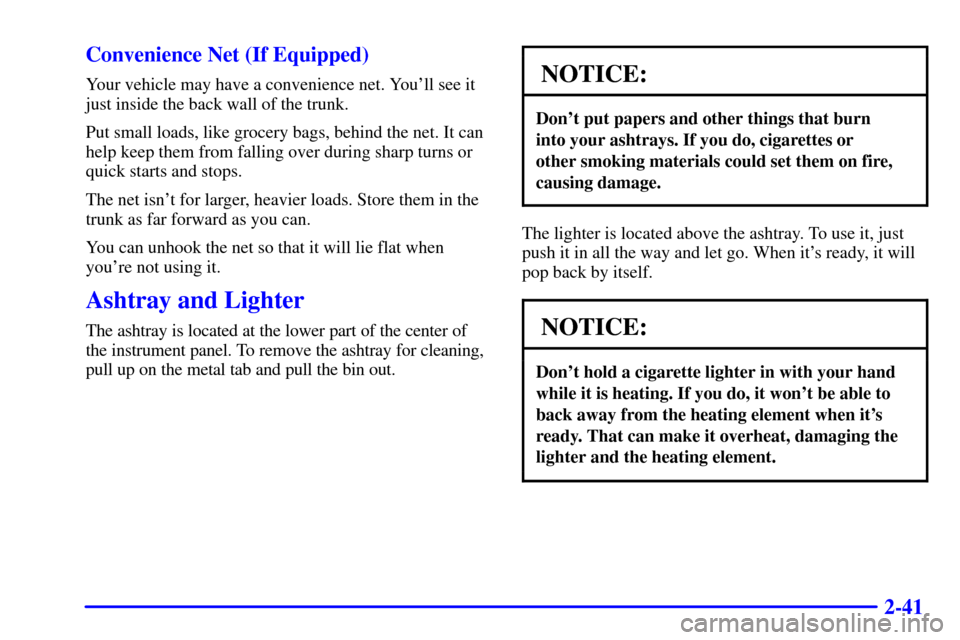
2-41 Convenience Net (If Equipped)
Your vehicle may have a convenience net. You'll see it
just inside the back wall of the trunk.
Put small loads, like grocery bags, behind the net. It can
help keep them from falling over during sharp turns or
quick starts and stops.
The net isn't for larger, heavier loads. Store them in the
trunk as far forward as you can.
You can unhook the net so that it will lie flat when
you're not using it.
Ashtray and Lighter
The ashtray is located at the lower part of the center of
the instrument panel. To remove the ashtray for cleaning,
pull up on the metal tab and pull the bin out.
NOTICE:
Don't put papers and other things that burn
into your ashtrays. If you do, cigarettes or
other smoking materials could set them on fire,
causing damage.
The lighter is located above the ashtray. To use it, just
push it in all the way and let go. When it's ready, it will
pop back by itself.
NOTICE:
Don't hold a cigarette lighter in with your hand
while it is heating. If you do, it won't be able to
back away from the heating element when it's
ready. That can make it overheat, damaging the
lighter and the heating element.
Page 115 of 326
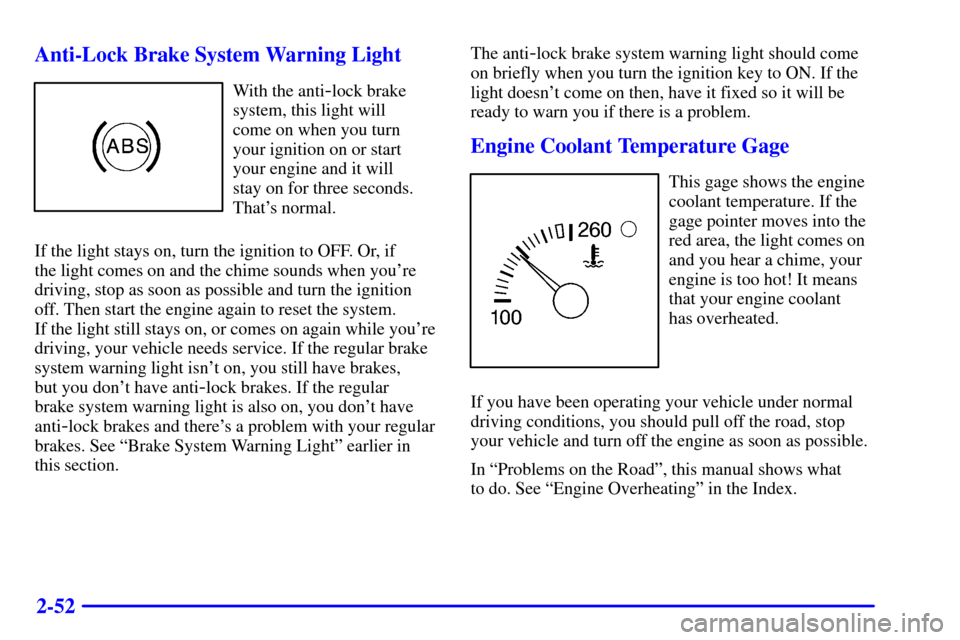
2-52 Anti-Lock Brake System Warning Light
With the anti-lock brake
system, this light will
come on when you turn
your ignition on or start
your engine and it will
stay on for three seconds.
That's normal.
If the light stays on, turn the ignition to OFF. Or, if
the light comes on and the chime sounds when you're
driving, stop as soon as possible and turn the ignition
off. Then start the engine again to reset the system.
If the light still stays on, or comes on again while you're
driving, your vehicle needs service. If the regular brake
system warning light isn't on, you still have brakes,
but you don't have anti
-lock brakes. If the regular
brake system warning light is also on, you don't have
anti
-lock brakes and there's a problem with your regular
brakes. See ªBrake System Warning Lightº earlier in
this section.The anti
-lock brake system warning light should come
on briefly when you turn the ignition key to ON. If the
light doesn't come on then, have it fixed so it will be
ready to warn you if there is a problem.
Engine Coolant Temperature Gage
This gage shows the engine
coolant temperature. If the
gage pointer moves into the
red area, the light comes on
and you hear a chime, your
engine is too hot! It means
that your engine coolant
has overheated.
If you have been operating your vehicle under normal
driving conditions, you should pull off the road, stop
your vehicle and turn off the engine as soon as possible.
In ªProblems on the Roadº, this manual shows what
to do. See ªEngine Overheatingº in the Index.
Page 116 of 326

2-53 Low Coolant Warning Light
This light comes on
briefly when you turn
your ignition on.
If this light comes on and stays on, the vehicle
should promptly be pulled off the road and the coolant
level checked.
See ªEngine Coolantºin the Index. If there are visible
signs of steam, see ªEngine Overheatingº in the Index
before opening the hood. Have your vehicle serviced as
soon as you can.
Malfunction Indicator Lamp
(Check Engine Light)
United States Canada
Your vehicle is equipped with a computer which
monitors operation of the fuel, ignition and emission
control systems.
This system is called OBD II (On
-Board
Diagnostics
-Second Generation) and is intended to
assure that emissions are at acceptable levels for
the life of the vehicle, helping to produce a cleaner
environment. The CHECK ENGINE light comes on
to indicate that there is a problem and service is
required. Malfunctions often will be indicated by the
system before any problem is apparent. This may
prevent more serious damage to your vehicle. This
system is also designed to assist your service technician
in correctly diagnosing any malfunction.
Page 123 of 326
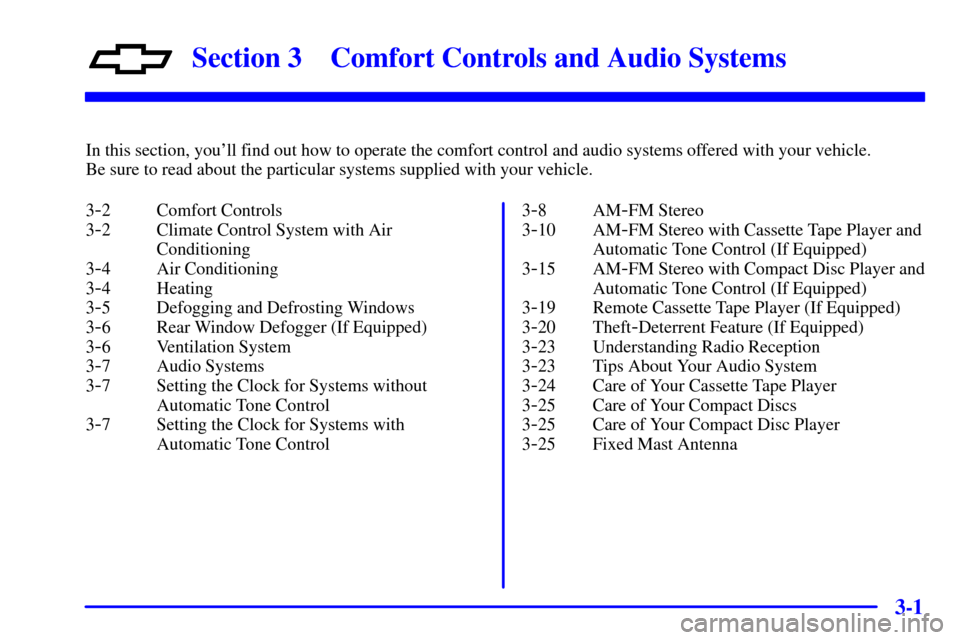
3-
3-1
Section 3 Comfort Controls and Audio Systems
In this section, you'll find out how to operate the comfort control and audio systems offered with your vehicle.
Be sure to read about the particular systems supplied with your vehicle.
3
-2 Comfort Controls
3
-2 Climate Control System with Air
Conditioning
3
-4 Air Conditioning
3
-4 Heating
3
-5 Defogging and Defrosting Windows
3
-6 Rear Window Defogger (If Equipped)
3
-6 Ventilation System
3
-7 Audio Systems
3
-7 Setting the Clock for Systems without
Automatic Tone Control
3
-7 Setting the Clock for Systems with
Automatic Tone Control3
-8 AM-FM Stereo
3
-10 AM-FM Stereo with Cassette Tape Player and
Automatic Tone Control (If Equipped)
3
-15 AM-FM Stereo with Compact Disc Player and
Automatic Tone Control (If Equipped)
3
-19 Remote Cassette Tape Player (If Equipped)
3
-20 Theft-Deterrent Feature (If Equipped)
3
-23 Understanding Radio Reception
3
-23 Tips About Your Audio System
3
-24 Care of Your Cassette Tape Player
3
-25 Care of Your Compact Discs
3
-25 Care of Your Compact Disc Player
3
-25 Fixed Mast Antenna
Page 124 of 326
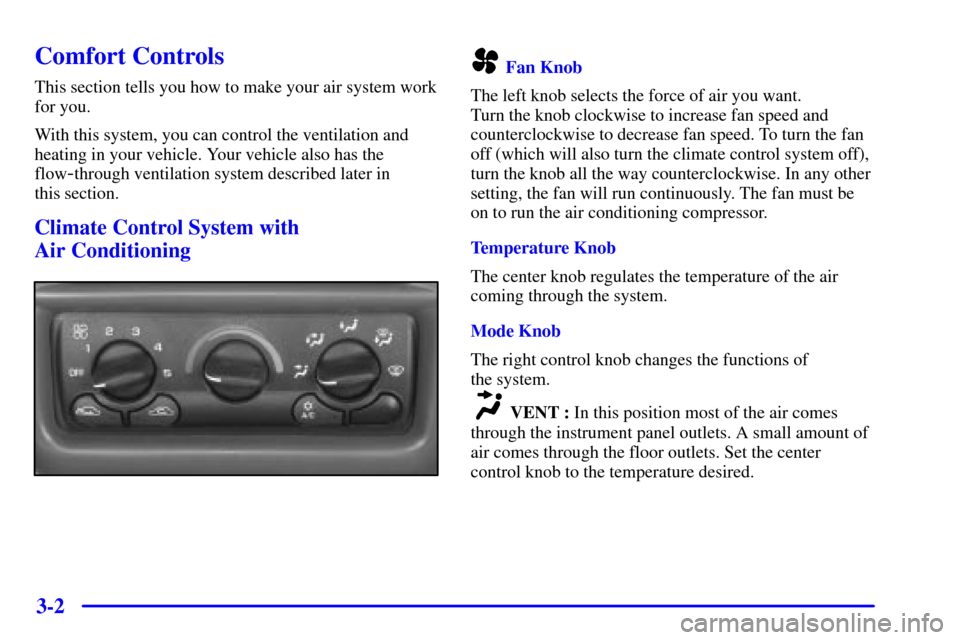
3-2
Comfort Controls
This section tells you how to make your air system work
for you.
With this system, you can control the ventilation and
heating in your vehicle. Your vehicle also has the
flow
-through ventilation system described later in
this section.
Climate Control System with
Air Conditioning
Fan Knob
The left knob selects the force of air you want.
Turn the knob clockwise to increase fan speed and
counterclockwise to decrease fan speed. To turn the fan
off (which will also turn the climate control system off),
turn the knob all the way counterclockwise. In any other
setting, the fan will run continuously. The fan must be
on to run the air conditioning compressor.
Temperature Knob
The center knob regulates the temperature of the air
coming through the system.
Mode Knob
The right control knob changes the functions of
the system.
VENT : In this position most of the air comes
through the instrument panel outlets. A small amount of
air comes through the floor outlets. Set the center
control knob to the temperature desired.
Page 126 of 326

3-4 Air Conditioning
The air conditioner and heater work best if you keep
your windows closed while using them. Your vehicle
also has the flow
-through ventilation system described
later in this section.
On very hot days, open the windows long enough to let
hot inside air escape. This reduces the time it takes for
your vehicle to cool down, which should help
fuel economy.
On cool, but sunny days, the sun may warm your upper
body, but your lower body may not be warm enough.
You can use BI
-LEVEL with the temperature knob in
the middle and the A/C button pushed in. The system
will bring in outside air and direct slightly warmer air to
your lower body.
For quick cool
-down on very hot days, use VENT with
the temperature knob all the way in the blue area and the
A/C and recirculation buttons pressed. If this setting is
used for long periods of time, the air in your vehicle
may become too dry.
For normal cooling on hot days, use VENT with the
temperature knob in the blue area and the A/C button
pushed in. The system will bring in outside air and
cool it.
Heating
On cold days, use FLOOR and the OUTSIDE AIR
button with the temperature knob all the way in the red
area. The system will bring in outside air, heat it and
send it to the floor outlets.
Your vehicle has heat ducts that are directed toward the
rear seat. Keep the area under the front seats clear of
obstructions so the heated air can reach the rear
seat passengers.
If your vehicle has an engine coolant heater, you can use
it to help your system provide warm air faster when it's
cold outside (0�F (
-18�C) or lower). An engine coolant
heater warms the coolant your engine and heating
system uses to provide heat. See ªEngine Coolant
Heaterº in the Index.